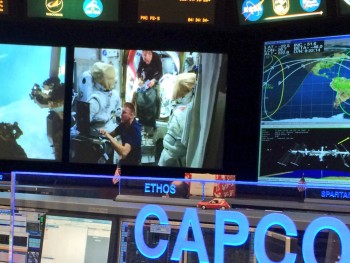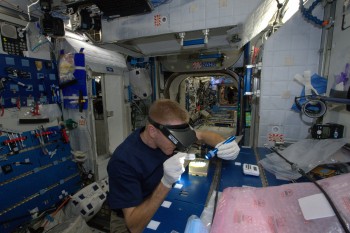These weeks in space have been busy for Tim Peake. Less than two weeks into his first mission on the International Space Station he supported a spacewalk from the inside and now within a month of arriving he has been assigned a sortie of his own with Tim Kopra. His spacesuit was checked and approved on 4 January – each spacesuit is adapted to the user.
On the same day Tim Peake started work on NASA’s ACE-H2 experiment (Advanced Colloids Experiment-Heated-2) that is looking at self-assembling materials with colloids – small particles suspended in a liquid. Tim used a microscope to examine the microscopic particles as they settled into place. On Earth gravity would pull on the colloids and interfere with the experiment.
In the evening Tim started on the first session ever of the Canadian experiment Vascular Echo. Previous research showed that astronauts arteries can stiffen rapidly, usually associated with ageing and inactivity on Earth. This follow-on experiment seeks to find out why.
Tuesday 5 January was spent preparing for the spacewalk by inspecting and organising tools. He also did his daily exercise and had his first use of the Station’s Ham radio to talk to a school in the US. Wednesday was spent on Tim’s spacesuit again. On Thursday Tim spent the morning using ultrasound to image his blood vessels for Vascular Echo and in the afternoon he did more spacewalk preparations – including checking the SAFER jetpack that is used in the unlikely event an astronaut floats away from the Space Station untethered.
Friday morning Tim spoke to a school in the UK over the ham radio and worked on preparing more experiments in the Japanese Kibo laboratory.
Next week

Tim Peake and Tim Kopra working on their spacesuits seen on a monitor of NASA mission control. Credits: David Saint-Jacques
After the weekend house-cleaning and Sunday day-off, next week will see Tim continue working on his spacewalk with Tim Kopra. Hilde Stenuit from ESA’s mission science office remarks: ““Despite this busy period in the run-up to the spacewalk we still see lots of time spent on science operations”
When Tim is not working on the spacewalk he will help fire up the Japanese Furnace to research space-age metals, and looking at how gut bacteria are affected by living on the International Space Station.
For the European Space Agency Tim will continue reporting on the presence of any headaches and record how his skin is coping in space for the Skin-B experiment. Skin-B collects data on skin structure, oxygenation, hydration and elasticity. The goal is to develop a computer model of how skin ages. Results on Tim’s skin will improve the model and could contribute to protecting people’s skin on Earth as well as in space.
For NASA some of Tim’s activities include depressurising the Japanese airlock in preparation of launching the microsatellite pair Lonestar-2 that will fly through space to test communications and autonomous navigation and rendezvous between satellites.


Discussion: 10 comments
Great blog and fascinating updates. Thank you. I’m really intrigued as to what you can do on days off? Is it anything like a raining day at home inside?
Wonderful insight into the real stuff our Tim with The Right Stuff gets up to. Thanks, and keep it coming. Even more detail welcome, eg photos of tools and toolbag and how the order of tools is planned
tim is an astronaut
the launch as an hour long and it was meh
hiii tim
your work as an astronaut brilliant.
you are so clever
i have questions how were you chosen and who are your parents and how old are you.also have you go any siblings and how famous are you. are you rich who are your friends where do you live and what country. how do we become astronauts and last did you have any other jobs???.
how is it up in the space station whats it like
Great blog and fascinating updates. Thank you. I’m really intrigued as to what you can do on days off? Is it anything like a raining day at home inside?